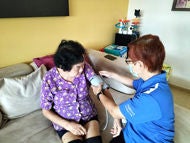What is - Cervical Spondylosis

What is cervical spondylosis?
Cervical spine is made up of bones (vertebraes) with cushions (discs) between them. As we grow older, the bones and the discs will degenerate. Bone spurs (osteophytes) may form and spinal canal may narrow (stenosis). These changes are known as cervical spondylosis.
Symptoms of Cervical Spondylosis
What are the symptoms of cervical spondylosis?
As the spine degenerates, osteophytes formation occurs which intends to fuse the vertebrae together to minimise movement. These osteophytes may cause the unwanted symptoms once it comes into contact with any of the nerve root or the spinal cord. The symptoms vary with each individual.
You may experience:
- Neck pain
- Constant deep ache that radiates over the shoulder and down to the arms, hands and fingers numbness or weakness of the arms, hands, fingers or legs
- Muscles spasm, neck stiffness
- Headache
- Neck and arm pain can be caused by compression of nerves travelling from cervical spine to arm
Cervical Spondylosis - How to prevent
How can cervical spondylosis be prevented?
There is no specific way to prevent this condition. However, some lifestyle modifications may slow the process of the degeneration.
Lifestyle Modifications include:
- Regular strengthening and flexibility exercises for neck and back muscles
- Regular aerobic exercises e.g. running, swimming, cycling
- Postural awareness to maintain good posture
- Workplace modifications to reduce stress to the back and neck
- Quit smoking
- Maintain healthy weight range
Diagnosis of Cervical Spondylosis
How is cervical spondylosis diagnosed?
The doctor will perform physical examinations including x-rays. Magnetic Resonance Imaging (MRI) studies are also helpful. These imagings may indicate abnormalities and reveal the extent of damage to the cervical spine.
Treatment for Cervical Spondylosis
How is cervical spondylosis treated?
Your symptoms may last for several months to years. If you have mild symptoms, the doctor may recommend some rest, medication and physical therapy. Surgery will be the last option.
Rest
In the acute phase, you may need to wear a cervical collar to limit neck movement and relieve the nerve irritation.
Medication
The doctor may prescribe some non-steroidal anti-inflammatory medications (nSaiDs) or other pain relievers to relieve pain and reduce swelling. Usage of muscle relaxants may be useful.
Physical therapy
A cervical traction, hot/cold therapy or active exercise programme may help to relieve symptoms. Exercises aim to improve muscle strength and flexibility.
Surgery
It is only necessary if you have severe pain that does not improve with other treatments or when there is progressive neurological symptoms.
Cervical Spondylosis - Other Information
References
- Benjamin Bjerke, M. (n.d.). What you need to know about neck arthritis. Spine. https://www.spine-health.com/blog/what-you-need-know-about-neck-arthritis
- Cervical spondylosis. Physiopedia. (n.d.). https://www.physio-pedia.com/Cervical_Spondylosis
- Lumbar and cervical spondylosis: Symptoms & treatments: HSS. Hospital for Special Surgery. (n.d.). https://www.hss.edu/conditions_spondylosis-overview.asp
- Cervical spondylosis (arthritis of the neck) - orthoinfo - aaos. OrthoInfo. (n.d.). https://orthoinfo.aaos.org/en/diseases--conditions/cervical-spondylosis-arthritis-of-the-neck/
- Guan, H. (2022). Cervical spondylosis. Radiopaedia.Org. https://doi.org/10.53347/rid-159179
Contributed by
The information provided is not intended as medical advice. Terms of use. Information provided by SingHealth.
Get to know our doctors at SingHealth Hospitals in Singapore.
Get to know our doctors at SingHealth Hospitals in Singapore. here.




















